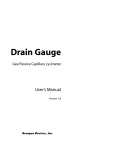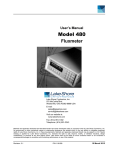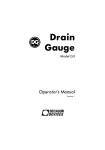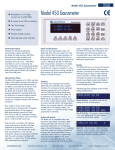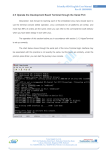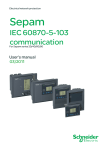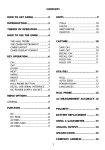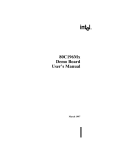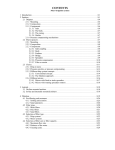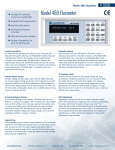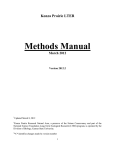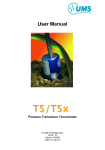Download Drain Gauge
Transcript
Drain Gauge Model G2 Gee Passive Capillary Lysimeter Operator’s Manual Version 5 Decagon Devices, Inc. 2365 NE Hopkins Court Pullman WA 99163 USA Tel: 1-509-332-2756 Drain Gauge User’s Manual Contents Contents 1. Introduction . . . . . . . . . . . . . . . . . . . . . . . . . . . . . Welcome . . . . . . . . . . . . . . . . . . . . . . . . . . . . . . . . Contact Information. . . . . . . . . . . . . . . . . . . . . . . Warranty Information. . . . . . . . . . . . . . . . . . . . . Seller’s Liability . . . . . . . . . . . . . . . . . . . . . . . . . . 1 1 1 1 1 2. Installing the Drain Gauge . . . . . . . . . . . . . . 3 Location Preparation . . . . . . . . . . . . . . . . . . . . . . 3 Excavation. . . . . . . . . . . . . . . . . . . . . . . . . . . . . . . 4 Method 1 (Disturbed Sample): . . . . . . . . . . . . . . 4 Method 2 (Intact Monolith) (Recommended): . . 6 Installation - Wick Section . . . . . . . . . . . . . . . . . 7 Installation - Divergence Tube . . . . . . . . . . . . . . 9 Method 1 (Disturbed Sample method): . . . . . . . . 9 Method 2 (Intact Soil Monolith method): . . . . 10 Post-Installation Warning . . . . . . . . . . . . . . . . 10 Installation: Valve Box. . . . . . . . . . . . . . . . . . . . . 11 Troubleshooting . . . . . . . . . . . . . . . . . . . . . . . . . 12 Solution Sampling. . . . . . . . . . . . . . . . . . . . . . . . 12 Water Balance . . . . . . . . . . . . . . . . . . . . . . . . . . 13 3. Theory . . . . . . . . . . . . . . . . . . . . . . . . . . . . . . . . . How the Drain Gauge Works . . . . . . . . . . . . . Considerations . . . . . . . . . . . . . . . . . . . . . . . . . . Depth of Installation . . . . . . . . . . . . . . . . . . . . Divergence Control Tube Length . . . . . . . . . . . Soil Disturbance . . . . . . . . . . . . . . . . . . . . . . . Soil-Wick Contact . . . . . . . . . . . . . . . . . . . . . i 14 14 14 16 17 18 18 Drain Gauge User’s Manual Contents 4. Collecting Data . . . . . . . . . . . . . . . . . . . . . . . . 19 Features . . . . . . . . . . . . . . . . . . . . . . . . . . . . . . . . 19 Wiring Diagrams . . . . . . . . . . . . . . . . . . . . . . . . 21 3.5mm plug wiring . . . . . . . . . . . . . . . . . . . . . . 21 Adapter cable wiring . . . . . . . . . . . . . . . . . . . 21 Extension cables . . . . . . . . . . . . . . . . . . . . . . . . . 22 Datalogger Requirements. . . . . . . . . . . . . . . . . 23 Decagon Em50, and Em50R loggers . . . . . . . 23 Other Data Logging Systems . . . . . . . . . . . . . 23 Important Considerations . . . . . . . . . . . . . . . . .24 Connecting to a Datalogger. . . . . . . . . . . . . . .24 Drainage Calculation, Data Analysis, & Calibration. . . . . . . . . . . . . . . . . . . 25 Root Incursion . . . . . . . . . . . . . . . . . . . . . . . . .27 Sample Program . . . . . . . . . . . . . . . . . . . . . . . . . 28 Troubleshooting . . . . . . . . . . . . . . . . . . . . . . . . .30 Further Reading . . . . . . . . . . . . . . . . . . . . . . . . . . 32 Declaration of Conformity . . . . . . . . . . . . . . . . 33 Index . . . . . . . . . . . . . . . . . . . . . . . . . . . . . . . . . . . . .35 ii Drain Gauge User’s Manual 1. Introduction 1. Introduction Welcome Thank you for purchasing the Drain Gauge. The Drain Gauge is designed for long-term monitoring of soil water drainage, with an estimated minimum 10-year lifetime. The Drain Gauge also has a collection system that allows for rapid sampling of drainage waters. This innovative device will enable you to monitor soil water movement and chemical leaching accurately and affordably. Contact Information • • • E-mail: [email protected] Fax: (509) 332-5158 Phone: 1-800-755-2751 (US and Canada only) or 509332-2756. Warranty Information The Drain Gauge has a 30-day satisfaction guarantee and a one-year warranty. Seller’s Liability Seller warrants new equipment of its own manufacture against defective workmanship and materials for a period of one year from date of receipt of equipment (the results of ordinary wear and tear, neglect, misuse, accident and excessive deterioration due to corrosion from any cause are not to be considered a defect); but Seller’s liability for 1 Drain Gauge User’s Manual 1. Introduction defective parts shall in no event exceed the furnishing of replacement parts F.O.B. the factory where originally manufactured. Material and equipment covered hereby which is not manufactured by Seller shall be covered only by the warranty of its manufacturer. Seller shall not be liable to Buyer for loss, damage or injuries to persons (including death), or to property or things of whatsoever kind (including, but not without limitation, loss of anticipated profits), occasioned by or arising out of the installation, operation, use, misuse, nonuse, repair, or replacement of said material and equipment, or out of the use of any method or process for which the same may be employed. The use of this equipment constitutes Buyer’s acceptance of the terms set forth in this warranty. There are no understandings, representations, or warranties of any kind, express, implied, statutory or otherwise (including, but without limitation, the implied warranties of merchantability and fitness for a particular purpose), not expressly set forth herein. 2 Drain Gauge User’s Manual 2. Installing the Drain Gauge 2.Installing the Drain Gauge Several references on Drain Gauge installation techniques are given at the end of this section, and two of those methods are discussed below. The one that you should use depends on your soil type and the purpose of your research. If your goal is to investigate an undisturbed soil core (recommended), you will need to secure a soil monolith inside the divergence control tube. However, in some cases, repacking the soil in layers is sufficient. Both methods are explained below. Location Preparation 1. Select a location for your installation (allow plenty of room to move around the hole) and lay a tarp nearby that can be used to hold the vegetation and soil that will be removed from the site. 2. Remove the surface vegetation and place it on the tarp. Try to preserve as much of the root mass as possible. Also, it is important to organize the vegetation you remove so that it can be replaced as closely as possible to its original location. 3 Drain Gauge User’s Manual 2. Installing the Drain Gauge Figure 6: Initial excavation above DCT hole. Excavation The depth of the Divergence Control Tube (DCT) hole depends on the depth of the root zone. The objective of the installation is to place the middle plate of the Drain Gauge below the root zone of the cover vegetation. Thus, the depth of the hole will vary between installations, but it must be at least 70 cm deep. The DCT should be completely buried below the soil surface. There are two different methods (see above) for installing the drain gauge, depending on whether you use a disturbed sample (Method 1) or an intact monolith (Method 2). Method 1 (Disturbed Sample): Digging the hole for the Drain Gauge is most effective with a sharpshooter shovel or post-hole digger and an orchard auger with a long extension. 1. Make the initial vertical hole (for the divergence control tube) about 25 cm (10 in.) in diameter (slightly larger than the tube itself) and at least 70 cm (27.5 in.) deep. 4 Drain Gauge User’s Manual 2. Installing the Drain Gauge 2. Dig a 7.5 cm (3 in.) diameter by 122 cm (4 ft.) deep hole for the PVC pipe that surrounds the wick section of the drain gauge at the bottom-center of the DCT hole you just made. An orchard auger can be very effective for this portion of the hole because of its long handle. 3. Insert the PVC tube (included with your drain gauge) into the wick section hole. This tube will help protect the wick section and prevent contamination of the lower sampling chamber from surrounding soil. 4. Pour 12 inches of rock, gravel, or sand into the PVC tube. This will allow for free movement of the effluent water from the Drain Gauge. Be sure not to overfill the PVC pipe with gravel, as the Drain Gauge plate should sit flush on the top of the PVC pipe. 5. If an auger was not used to dig the wick section hole, and a significant gap remains between the soil and the PVC tube, pour some additional gravel or sand into this gap, and backfill with soil. 5 Drain Gauge User’s Manual 2. Installing the Drain Gauge Figure 1: Installation of protective PVC pipe and gravel Method 2 (Intact Monolith) (Recommended): If you would like an undisturbed soil monolith, it can be obtained from either the installation site or an adjacent site. If you choose a monolith from an adjacent but similar site, you can minimize disturbance to your measurement site. 1. Carefully remove soil to the depth where you want the top of the DCT to be. Note: The hole you dig must be wide enough to allow you to easily dig around the outside of the DCT. 2. Place the DCT at the bottom-center of the hole. Pound the DCT into the soil by by placing a board on top of the tube (to prevent damaging the tube) and 6 Drain Gauge User’s Manual 2. Installing the Drain Gauge striking it repeatedly with a sledgehammer. Then, dig away the soil around the portion of the DCT that you just pounded into the soil. Repeat the process until the DCT is filled with soil. 3. Use a shovel to free the DCT from the surrounding soil and lay it aside. 4. If you have harvested a monolith from a separate site than you wish to install your drain gauge, use an 8” auger to dig a narrow hole for your DCT in the location in the location where you wish to take your measurement. 5. Finally, dig the hole for the wick section according to Method 1. Installation - Wick Section 1. Cut a slot into the soil at the top of the wick section hole so the tubes and wire can pass under the edge of the middle plate without damage. 2. Make sure the protective PVC pipe is installed in the hole such that the top of the pipe is flush with the bottom of the DCT hole, and that the notch in the PVC is aligned with the slot you just cut in the soil. Then carefully lower the wick section into the hole, being especially careful not to kink or break the sensor wire and calibration and sampling tubes. The plate should rest on the shoulder around the wick section hole, flush with the top edge of the PVC pipe. The tubes and wire should pass out through the notch in the PVC pipe and the slot in the soil. 7 Drain Gauge User’s Manual 2. Installing the Drain Gauge 3. After the lower section is installed, check to make sure it is roughly level. Apply a 2 cm (3/4 in.) thick layer of diatomaceous earth (included in your Drain Gauge kit) on top of the fiberglass fabric. The diatomaceous earth will enhance the contact between the soil in the DCT and the fiberglass wick. Note: in order to make sure there is enough space beneath the Drain Gauge for proper drainage, DO NOT pound the wick tube into the ground. This can lead to improper drainage and potentially clog the drainage ports. Figure 2: Lower wick section installed 8 Drain Gauge User’s Manual 2. Installing the Drain Gauge Installation - Divergence Tube Depending on whether or not you are using the “Disturbed Sample” method or “Intact Soil Monolith” method described earlier, there are also two different methods for installing the DCT (divergence control tube): Method 1 (Disturbed Sample method): 1. Set the empty DCT on top of the plate segment of the wick section. The outer edge of the DCT should fit inside the lip of the plate. 2. Repack the soil you removed from the DCT hole. Take care to repack the soil layers in the same order that they came out, and at the approximate density as the adjacent undisturbed soil. 3. Place and pack the soil from the root zone. You may want to mound additional soil on top of the drain gauge to compensate for soil settling. Replace the cover vegetation, if desired. Some users keep subsurface soil moist and allow it to settle for a week prior to replacing the topsoil and vegetation. 4. Backfill and pack soil around the outside of the DCT. 5. Place and pack the soil from the root zone. You may want to mound additional soil on top of the drain gauge to compensate for soil settling. Replace the cover vegetation, if desired. Some users keep subsurface soil moist and allow it to settle for a week prior to replacing the topsoil and vegetation. 9 Drain Gauge User’s Manual 2. Installing the Drain Gauge Method 2 (Intact Soil Monolith method): 1. Set the DCT containing the intact soil monolith onto the diatomaceous earth that was applied on top of the fiberglass fabric, on top of the wick section plate. Figure 3: DCT installation, filled with intact soil monolith 2. Backfill and pack the soil around the outside of the DCT. 3. Place and pack the soil from the root zone. You may want to mound additional soil on top of the drain gauge to compensate for soil settling. Replace the cover vegetation, if desired. Some users keep subsurface soil moist and allow it to settle for a week prior to replacing the topsoil and vegetation. Post-Installation Warning To reduce the amount of time until the soil equilibrates back to a more natural state, many users moderately irrigate the Drain Gauge immediately after installation. If you wish to do this, make sure not to irrigate too heavily and too quickly. Over-irrigation of unconsolidated soil can cause preferential flow of solids down the PVC tube, which fills the gravel with fine sediments that can retard drainage from the Drain Gauge’s overflow port. In 10 Drain Gauge User’s Manual 2. Installing the Drain Gauge extreme cases, sediments can also enter the sampling reservoir, leading to erroneous readings. This will not occur once the soil has experienced moderate irrigations or rainfall events. Figure 4: Final Drain Gauge installation Installation: Valve Box We recommend that you install a sprinkler valve box next to the Drain Gauge to provide easy access and protection to the calibration and sampling tubes. Valve boxes are readily available from sprinkler supply stores. The valve box should be placed far enough away from the Drain Gauge installation so it does not interfere with the site. 1. First, dig a hole large enough to accommodate the valve box. 11 Drain Gauge User’s Manual 2. Installing the Drain Gauge 2. Cut a small trench between the Drain Gauge site and the valve box installation site (we recommend this step be completed before replacing the surface vegetation on top of the Drain Gauge). 3. Lay the sensor wire and calibration and sampling tubes in the trench and recover them. 4. Place the valve box into the hole and arrange the tubes so they can be easily accessed. Troubleshooting When the Drain Gauge’s read circuit is excited by 2.5 volts, the sensor output with a dry sampling chamber should be ~ 10 mV, and the output when full should be ~120-125 mV. The siphon does not drain the measurement reservoir completely, so the sensor should read ~30 mV after a siphon event. Each of these values can vary ± 10% from instrument to instrument. If the probe output is not between 10 and 135 mV, check to be sure the sensor wire was not damaged during installation. If you do not see a flushing event after injecting water into the calibration tube, pull air into the syringe and inject it into the tube. This should push all the water out of the sampling tube and into the reservoir. Solution Sampling The sample reservoir collects water from the measurement reservoir after each flush. Solution can be retrieved from the sample reservoir through the blue sampling tube. Insert a 60cc syringe (included) into the sampling tube and slowly pull back on the plunger. If liquid is present in the sampling reservoir, it should slowly begin 12 Drain Gauge User’s Manual 2. Installing the Drain Gauge filling the syringe. Note: The syringe will never completely fill with water. NOTE: The liquid in the syringe will be a mix of the all the water that has collected in the reservoir over time. You should not assume that the composition of the sample water is specific to a single flush event from the reservoir, unless you are certain that you have emptied the reservoir since the previous flush. Water Balance It is often useful to install ECHO soil moisture probes within the divergence control tube to observe how the water content changes with depth over time in the DCT. If you install ECHO probes in the DCT, you must take care so they are not touching any part of the DCT, as this will adversely affect the readings. A good rule of thumb is to locate them as close to the center of the divergence tube as possible. 13 Drain Gauge User’s Manual 3. Theory 3. Theory How the Drain Gauge Works The Drain Gauge is first installed below the root zone. Water infiltrates down through the divergence control tube, and then down a fiberglass wick into a collector. As collected water fills the measurement reservoir, the water level is monitored by a water depth sensor. When the water level in the measurement reservoir reaches the top of the siphon tube, the water empties and the event is recorded by an attached data logger. The emptied water then drains into the sampling reservoir. A sampling syringe, attached to the water reservoir sampling port (blue tube), can draw water samples out of the sampling reservoir for chemical analysis. Excess water drains out of an overflow port and into the soil while allowing a volume of water to remain for sampling (see fig. 7). Considerations A soil water balance takes into consideration the inputs, losses and storage of water in a soil profile. An important component of the water balance is the water that drains from the bottom of the soil profile, often referred to as “deep drainage” or “deep percolation.” This is water that has gone sufficiently far below the root zone that it cannot be removed from the soil by transpiration or evaporation. The other components of the water balance can be measured, but the deep drainage typically has been computed as the remainder when the other components were mea14 Drain Gauge User’s Manual 3. Theory sured and accounted for. Because of uncertainties in the measurements of the other water balance components, deep drainage estimates were subject to large errors. The Drain Gauge now allows direct measurement of the deep drainage component of the water balance. This is accomplished by intercepting and collecting a representative sample of the water that moves below the root zone. The Drain Gauge is sometimes referred to as a passive wick lysimeter. It has a specially treated fiberglass wick which maintains a tension on the water at the bottom of the soil profile where it is extracting water. Without this tension, water would “pile up” at the outflow boundary, and force the water in the soil above to move around the Drain Gauge, rather than into it. The divergence control tube on the top of the Drain Gauge is also for the purpose of maintaining vertical flow above the Gauge so that the Drain Gauge intercepts a representative sample. Both the amount of sample and its chemical composition need to be representative of deep drainage in the area where the drain gauge is installed. Whether or not this is true is determined largely by the installation. The main issues are: • Depth of installation • Soil disturbance above the Drain Gauge. • Contact between the wick and the soil profile. • Root incursion into the Drain Gauge wick section. Following are some general comments related to these issues. Specific installation procedures are then outlined in the next chapter. 15 Drain Gauge User’s Manual 3. Theory Depth of Installation In any soil profile, there is a zone of recharge and seasonal depletion extending to the bottom of the root zone. Since root density decreases with depth, the bottom of this zone may be difficult to locate. In annual crops it is typically around 1 m (3 ft.), but can be much deeper in perennials. There is, of course, a practical limit to how deep the Drain Gauge can be installed. With shallow-rooted crops this is not an issue, but with deep-rooted plants, one may need to strike a compromise between getting below all roots and installing the Drain Gauge at a practical depth. Even when roots go quite deep, the amount of water taken up by these roots may be quite small. Another consideration is the depth of the water table. The water table depth must always be below the bottom of the Drain Gauge so that water can drain out. This might sometimes require that the Drain Gauge be installed at a shallower depth than would be ideal to accommodate the root zone. The consequence of installing the Drain Gauge at too deep a depth is that it will require a long time to come to steady state and give drainage numbers that are representative. The consequence of installing it at too shallow a depth is an over-estimation of deep drainage because some water that would have been transpired is intercepted and measured as drainage. It is also possible that roots could grow down the wick and use water from, or clog the Drain Gauge. This can be minimized by the Treflanimpregnated root inhibitor fabric at the bottom of the divergence control tube (installed). 16 Drain Gauge User’s Manual 3. Theory Divergence Control Tube Length Optimal performance of traditional passive capillary lysimeters is only achieved by precisely matching wick length to soil type. The addition of an innovative divergence control tube (DCT) negates the need for precise wick-soil matching in the Drain Gauge. Numerical and laboratory simulations performed by Gee et al. (2002) have demonstrated the effectiveness of the DCT in preventing flux divergence around the collection point. Figure 5 shows the collection effectiveness of the drain gauge as a function of DCT height for six different flux rates in a coarse sand. It is apparent that in this medium, reasonable collection effectiveness can be achieved with a DCT height of as little as 30 cm, even at very low drainage fluxes where divergence most readily occurs. For finer textured soils, a DCT height of up to 60 cm may be necessary. In the extreme case of very fine soils with low drainage fluxes (i.e. <50 mm yr-1), a DCT height of more than 60 cm may be necessary to prevent flow divergence. Figure 5: Collection effectiveness of Drain Gauge for several different flux rates as a function of DCT height in a coarse sand. JA is the actual drainage flux, and Jm is the drainage flux measured by the Drain Gauge. Figure adapted from Gee et al. (2002). 17 Drain Gauge User’s Manual 3. Theory Soil Disturbance It is impossible to install the Drain Gauge without disturbing the soil. The goal is to install it in such a way that the disturbance has minimal impact on the Gauge's ability to measure deep drainage. The three factors that will affect deep drainage are: changes in root uptake patterns, changes in soil moisture storage, and changes in evaporation. In some cases, it may be necessary to install the Drain Gauge beneath an undisturbed core of soil. In all cases it will be necessary to allow time for roots to grow back into disturbed soil. If the soil surface is tilled, there is no point in trying to keep that part of the soil undisturbed, since it is already disturbed. Soil-Wick Contact In order for the bottom of the soil profile to be under tension, the tension in the wick must be transferred to the bottom of the soil column. There must therefore be good capillary continuity between the soil column and the wick. If the Drain Gauge is installed by backfilling with soil, the contact is likely to be good without further effort. If an undisturbed core is installed, capillary continuity is established by placing a layer of diatomaceous earth over the wick. The diatomaceous earth conforms to the irregularities of the soil and wick to provide continuity. 18 Drain Gauge User’s Manual 4. Collecting Data 4. Collecting Data Features Syringe Em5 Calibration (clear) and Sampling (blue) Tubes ROOT ZONE Sensor Cable Divergence Control Tube Fiberglass Fabric filter Treflan® Root Inhibitor Tubing Shield Wick Measurement Reservoir PVC sheath Sampling Reservoir Gravel 19 Drain Gauge User’s Manual 4. Collecting Data Siphon Measurement Reservoir Water depth sensor Calibration port Sensor cable port Tubing shield Sampling Reservoir Overflow port Sampling port Fig. 7: Close-up of Measurement section 20 Drain Gauge User’s Manual 4. Collecting Data Wiring Diagrams 3.5mm plug wiring The Drain Gauge’s water level sensor comes with a 3.5mm “stereo-plug” style connector. This allows for rapid connection directly to Decagon’s Em50 data logger. Below is a diagram showing the wiring configuration for this connector. Analog out (Red) Ground (Bare) Sensor cable Excitation (White) Fig. 8: Sensor plug wiring configuration Adapter Cable Wiring The sensor adapter cable (model PAP) for connection to non-Decagon equipment contains 3 wires as shown below. The adapter cables are available from Decagon upon request. The cable plug has integrated inductors designed to provide signal noise reduction. Refer to Chapter 4 for more details about connecting to a non-Decagon data logger. Analog out Ground Excitation Fig. 9: Adapter cable wiring configuration 21 Drain Gauge User’s Manual 4. Collecting Data NOTE: Be aware that cutting off the cable plug or cutting the cable in any other way will void your warranty, since the plug and cable are both specially engineered for optimal performance and noise reduction. Extension cables Decagon supplies 50-foot (15.25m) and 10-foot (3m) extension cables to attach to the sensor cable. You can safely connect up to 5 of the 50-foot cables without significant signal attenuation. For most applications, you will want to seal the connections from the elements to maintain a good connection and to prevent corrosion. To waterproof the connectors, connect the extensions, then coat the connection with silicone sealant. Next, cover the connection with heat shrink and shrink it over the uncured sealant. Datalogger Requirements Decagon Em50, and Em50R loggers The Drain Gauge's sensor is designed to work efficiently with Decagon's 5-channel Em50 data logger with firmware version 1.9 or higher. The Em50 automatically recognizes the Drain Gauge and keeps a running total of drainage since the last time the data logger memory was erased. The Em50 will output the cumulative drainage in units of 0.1mm. For example, if the Drain Gauge has experienced 7 siphon flushes and the siphon chamber is half full at the time of measurement storage, the output would be 75, indicating 7.5 mm of drainage. The total drainage will not reset to zero when data are downloaded 22 Drain Gauge User’s Manual 4. Collecting Data from the Em50, so the drainage reported is the cumulative amount since the Em50 memory was last erased. The Em50 will also output the water depth sensor ADC counts at each measurement interval. Other Data Logging Systems The Drain Gauge can also be adapted for use with other data loggers, such as those from Campbell Scientific, Inc. The Drain Gauge sensor requires an excitation in the range of 2-5 volts. Any data logger which can produce 2.55 V excitation with approximately 10 millisecond duration and read a volt-level signal with 12 bit or better resolution should be compatible with the Drain Gauge. The current requirement at 2.5 V is around 2 mA, and at 5V it is 78mA. The calibration equations presented in this manual are only valid for a 2.5 V excitation. If another excitation is chosen, then the user will need to calibrate the water depth sensor by injecting water into the clear calibration tube and recording the mV output of the sensor after each incremental injection. Important Considerations 1. The Drain Gauge sensor is intended only for use with data loggers and readout devices which can provide short excitation pulses. Continuous excitation not only wastes battery power, but may, under certain circumstances, cause the sensor to exceed government specified limits on electromagnetic emissions. 2. All Decagon readout devices use 3.0V excitation, so the remainder of the discussion assumes this as the excitation. If other voltages are used, adjustments to the calibration equations provided will be needed. 23 Drain Gauge User’s Manual 4. Collecting Data 3. If your data logger is programmed to wait too long between readings, you may miss a flushing event. Connecting to a Datalogger Connect the wires from the pigtail adapter to the data logger as shown, with the supply wire (white) connected to the excitation, the analog out wire (red) to an analog input, and the bare ground wire to ground: Supply Exc. Analog out Ground L H G Analog In Datalogger Fig. 10: Datalogger configuration Drainage Calculation, Data Analysis, & Calibration The Drain Gauge is designed with a flush volume of 31 cm3, ±10%. If the sampling area is taken as the surface area of the opening in the divergence control tube (310 cm2), each flush event corresponds to 1 mm of drainage. Em50 loggers with firmware v 1.9 and greater will automatically recognize the Drain Gauge, and keep a running count of Drain Gauge flushing events (see reading the Drain Gauge with Em50 loggers). With other data acquisi24 Drain Gauge User’s Manual 4. Collecting Data tion systems, the flushing events must be identified from the time series data from the drain gauge water depth sensor (Figure 11). The data will be characterized by filling and flushing events. A total count of the readily-apparent flushing events is multiplied by 1 mm to calculate the total drainage during the period of interest Figure 11: Typical time series data from Drain Gauge water depth sensor during wet conditions. A sample program for use with CSI data loggers is included at the end of this manual. If drainage resolution of less than 1 mm is desired, the drainage can be calculated from the volume of solution accumulated in the siphon chamber. The volume of solution in the siphon chamber can be calculated using the generic drain gauge calibration function: Vol (cm3) = 0.33 * mV - 9.8 25 Drain Gauge User’s Manual 4. Collecting Data where mV is the output from the water depth sensor in the siphon chamber. This generic calibration function should be accurate enough for nearly all applications. If extreme accuracy is desired in inter-flush solution volume measurement, then you must perform a custom calibration by incrementally injecting known volumes of local soil solution into the calibration port (clear tube) and recording sensor mV output after each solution injection. Note that care should be taken when performing a custom calibration to flush the entire injected solution volume from the calibration tube into the calibration chamber with air before recording the mV output from the water level sensor. Root Incursion If the Drain Gauge is installed at too shallow a depth, it is possible for plant roots to grow into the wick and either use water from, or potentially clog the drain gauge. To prevent this, each new drain gauge is shipped with a root inhibiting fabric (Bio-barrier™, Reemay, Inc.) placed below the wick fabric on the wick plate. This fabric is impregnated with Treflan® (Trifluralin) root inhibitor. The root inhibitor is slowly released into the soil surrounding the fabric, and builds up a layer of ~10cm thickness where roots will not penetrate. The effective lifetime of the Bio-barrier is several decades, so the fabric should not have to be replaced over the life of the drain gauge. Treflan is a mitosis inhibitor, which prevents plant roots from growing via cell splitting. It is possible (although unlikely) that the roots of woody species that grow via elongation may be able to penetrate the inhibitor layer and grow into the wick. If this is a concern, it may be necessary to place additional Bio-barrier in the divergence con26 Drain Gauge User’s Manual 4. Collecting Data trol tube during installation (contact Decagon for additional Bio-barrier). If you are confident that the drain gauge will be installed well below the potential root zone, or are concerned about the presence of trace amounts of Trifluralin in your solution analysis, the Bio-barrier fabric can be easily removed before installation. Simply remove the retaining ring and fiberglass filter that sit above the wick, and remove the Bio-barrier (yellow fabric with black knobs) that sits below the un-woven portion of the wick. Be sure to evenly spread the unwoven wick portion and re-fasten the fiberglass filter with the plastic retaining ring before installing the drain gauge. Sample Program The following is an abbreviated program that can be used with a CR10X data logger. This program outputs the raw mV output from the water level sensor during flushing events so that the flush volume can be calculated during post-processing, using either a factory supplied or custom calibration. The program additionally samples water level sensor mV signal once per hour. ;{CR10X} ; ;Drain Gauge Program ;This short program is designed to limit the ;amount of program memory used ;Note: due to minimization, this program ;requires significant post-processing ;Siphon chamber water level mV data are ;output every hour. Additional water ;level data are output during each siphon ;chamber flushing event. Drainage is ;calculated using the methods discussed ;earlier in the manual *Table 1 Program 01: 1 Execution Interval (seconds) 27 Drain Gauge User’s Manual 4. Collecting Data ;Shift previous water level measurement ; 1: Z=X (P31) 1: 1 X Loc [ WatrLevel ] 2: 2 Z Loc [ PrevLevel ] ;Read water level sensor and set current ;water level ; 2: Excite-Delay (SE) (P4) 1: 1 Reps 2: 5 2500 mV Slow Range 3: 1 SE Channel 4: 1 Excite all reps w/Exchan 1 5: 1 Delay (0.01 sec units) 6: 2500 mV Excitation 7: 1 Loc [ WatrLevel ] 8: 1.0 Mult 9: 0.0 Offset ;compare previous water level to current ;level 3: Z=X-Y (P35) 1: 1 X Loc [ WatrLevel ] 2: 2 Y Loc [ PrevLevel ] 3: 3 Z Loc [ DeltaWL ] ;Set threshold for identification of siphon ;event (10 mV decrease over 1 second) ; 4: If (X<=>F) (P89) 1: 3 X Loc [ DeltaWL ] 2: 4 < 3: -10 F 4: 30 Then Do ;set 10s period for outputting water ;level data to final storage after siphon ;flush slows ; 5: Z=F x 10^n (P30) 1: 1 F 2: 1 n, Exponent of 10 3: 4 Z Loc [ counter ] 6: End (P95) 7: 1: 2: 3: 4: If (X<=>F) (P89) 4 X Loc [ counter 3 >= 1 F 30 Then Do ] ;counter = counter -1 ; 8: Z=X+F (P34) 1: 4 X Loc [ counter 28 ] Drain Gauge User’s Manual 4. Collecting Data 2: -1 3: 4 F Z Loc [ counter ] ;Output time and water level data to ;final storage for 10s siphon chamber ;flushing event ; 9: Do (P86) 1: 10 Set Output Flag High (Flag 0) 10: Real Time (P77) 1: 1111 Year,Day,Hour/Minute,Seconds (midnight = 0000) 11: Sample (P70) 1: 1 Reps 2: 1 Loc [ WatrLevel ] 12: End (P95) ;Output time and water level every hour. ;These data provide information about ;infiltration events that are not large ;enough to cause gauge to flush, and are also ;useful to ensure that program is catching ;all gauge flush events ; 13: If time is (P92) 1: 0 Minutes (Seconds --) into a 2: 60 Interval (same units as above) 3: 10 Set Output Flag High (Flag 0) 14: Real Time (P77) 1: 1110 Year,Day,Hour/Minute (midnight = 0000) 15: Sample (P70) 1: 1 Reps 2: 1 Loc [ WatrLevel ] *Table 2 Program 02: 0.0000 Execution Interval (seconds) *Table 3 Subroutines End Program Troubleshooting If you encounter problems with the Drain Gauge sensor, they most likely will manifest themselves in the form of incorrect or erroneous readings. Before contacting Decagon about the sensor, do the following: 29 Drain Gauge User’s Manual 4. Collecting Data • • • Check the sensor cable to ensure it was not cut or damaged. Check to make sure the connections to the data logger are both correct and secure. Ensure that your data logger’s batteries are not dead or weakened. If you encounter problems specific to the Drain Gauge, please contact Decagon at (509) 332-2756 and at [email protected]. 30 Drain Gauge User’s Manual Further Reading Further Reading Gee, G.W. et al. “A vadose zone water fluxmeter with divergence control”. Water Resources Research, vol. 38,No. 8, 10.1029/2001 WR 000816, 2002 Gee, G.W., A.L. Ward, Z.F. Zhang and A. Anandacoomaraswamy. “Use of water fluxmeters to measure drainage”. pp.321-331. In: R.A. Cooke (ed.) Drainage VIII. Proceedings of the Eighth International Drainage Symposium. 21-24 Mar. 2004, Sacramento, CA., Am. Soc. Ag. Engr., St. Joseph, MI. Installation References Brown K.W. et al., 1974. “A procedure for placing large undisturbed monoliths in lysimeters”. Soil Sci. Soc. Am. J. 38:981-983. Quinlan,P., R, Burman and e. Siemer. 1982. In Situ lysimeter installation. ASAE Tech. Paper 82-2015. American Society of Agricultural Engineers, St. Joseph, MI. http://kilburn.keene.edu/research/hydrology/RLA/ index.html#lysimeter For more rigourous installation techniques http://www.soilsci.ndsu.nodak.edu/research/ soil_physics/bmp/1989/1989.html 31 Drain Gauge User’s Manual Declaration of Conformity Declaration of Conformity Application of Council Directive: 89/336/EEC Standards to which Conformity is Declared: EN61326: 1998 EN55022: 1998 Manufacturer’s Name: Decagon Devices, Inc. 2365 NE Hopkins Court Pullman, WA 99163 USA Type of Equipment: Gee Passive Capillary Lysimeter Drain Gauge. Model Number: G2 Year of First Manufacture: 2003 This is to certify that the Drain Gauge, manufactured by Decagon Devices, Inc., a corporation based in Pullman, Washington, USA meets or exceeds the standards for CE compliance as per the Council Directives noted above. All instruments are built at the factory at Decagon and pertinent testing documentation is freely available for verification. 32 Drain Gauge User’s Manual Index Index A adapter cable wire diagram 21 C calibration 12 CE compliance 33 contact information 1 D data analysis 12 datalogger requirements 23 sample program 28 Declaration of Conformity 33 drain gauge depth of installation 16 installation instructions 3 theory 2 drainage calculating 26 E email 1 extension cables 22 35 Drain Gauge User’s Manual Index F fax number 1 I installation 3 depth considerations 16 location 3 soil disturbance 18 P plug wiring configuration 21 probe layout 14 program 28 S sampling water 12 seller’s liability 1 soil disturbance 18 solution sampling 12 T telephone number 1 troubleshooting 12, 30 W warranty 1 water balance 13 wiring diagrams 20 36






































